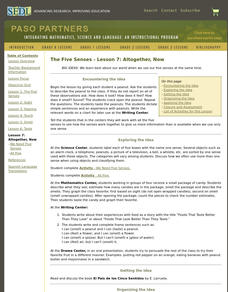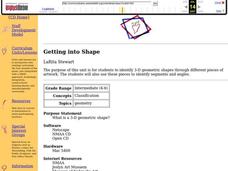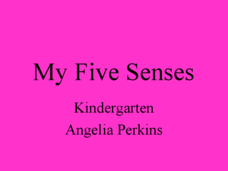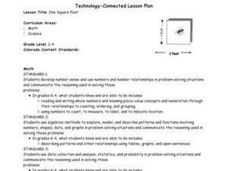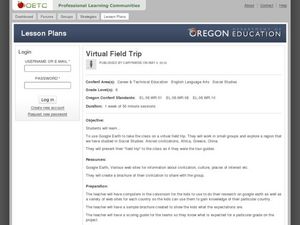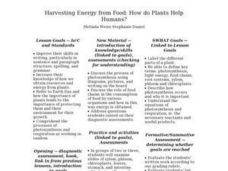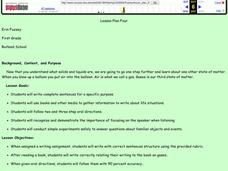Curated OER
Review of the Five Senses
Students investigate the five senses. In this human biology lesson, students are given five items and identify which items match best with each of the senses. Students use objects such as a rock, hard candy, and a flower.
Curated OER
Linear Inequalities
Students solve linear inequalities. In this solving linear inequalities lesson plan, students solve one step inequalities algebraically. Students graph the solutions on a number line. Students compare the graphs of various inequalities...
EngageNY
Solution Sets to Inequalities with Two Variables
What better way to learn graphing inequalities than through discovering your own method! Class members use a discovery approach to finding solutions to inequalities by following steps that lead them through the process and...
Curated OER
Easter Egg Surprise
Young readers describe objects by using describing words. After reviewing the five senses, they use their senses to gain information about an object. Then as homework, they write three descriptive words about a mystery object and place...
EngageNY
Informative Paragraph Pre-Assessment: What Is One Reason You Want the Power of Reading?
This writing pre-assessment has minimal instruction but maximum support and encouragement. It begins with a review of the book, Rain School, through a think-pair-share and small group discussion. The discussion...
Curated OER
Altogether, Now
Students apply their five senses to science, math, drama, and writing center activities.
Curated OER
Getting into Shape
Young scholars identify 3-D geometric shapes through different pieces of artwork. They examine and identify segments and angles. Students act out shapes and create a piece of artwork. Additional cross curriculum activities are listed.
Curated OER
My Five Senses
First graders work with a template and complete any incomplete sentences they find. They are to illustrate their sentences.
Curated OER
Keeping Your Heart in Good Shape: What are the Benefits? - Biology Teaching Thesis
Students name the main parts of the heart and what events occur there. They write a reaction that contains complete sentences, and uses proper spelling and grammar, after viewing a video. Students define the following terms: contraction,...
Curated OER
One Square Foot
Learners identify, describe, count, tally, and graph life found in one square foot of land.
Curated OER
Virtual Field Trip
This hands-on resource has future trip planners analyze graphs of mileage, gasoline costs, and travel time on different routes. While this was originally designed for a problem-solving exercise using a Michigan map, it could be used as a...
Curated OER
The Death of Old Woman Kelema
Young scholars read various parts of "The Death of Old Woman Kelema". Next, they listen to the author's description of her writing process. In groups, they compare and contrast funerals in Mali with those in the United States. They also...
Curated OER
Life Cycle of the Butterfly
Students observe and analyze the life cycle and metamorphosis of the Painted Lady Butterfly. They write observation journal entries three times a week and summarize what they observed. Using KidPix computer software they create pictures...
Benjamin Franklin Tercentenary
Learning the Printing Trade
Students explore U.S. History by reading biographical text in class. In this Benjamin Franklin instructional activity, students read about the famous American's first job and the transition he underwent from printing to politics....
Curated OER
What Do You See at the Pond?
With What Do You See at the Pond?, young readers explore pond life and practice reading strategies. Learners first make predictions and then read the simple story independently. After a second read-through with a partner, kids come...
EngageNY
Solution Sets to Simultaneous Equations (part 1)
How are systems related? Build on your pupils' previous knowledge of solving systems of equations by introducing systems of inequalities. Learners explore similarities between systems of equations and inequalities to make a strong...
Curated OER
Harvesting Energy from Food: How do Plants Help Humans?
Beginning botanists view slides of plant vascular tissue. They watch Magic School Bus Gets Planted, which you can find online, and then write a summary of what they have learned about plants. This lesson plan could be used with upper...
Curated OER
The Wonders of Water - Biology Teaching Thesis
Students name 3-5 aesthetic values of the Potomac River. They state the importance of water in their own words. Students describe what Earth Day is and why it is important. They list 5-7 ways that they can help minimize water pollution.
Curated OER
Introduction to Juvenile Delinquency
Students discuss cases in which juveniles were convicted of horrific crimes. They answer questions in which there are no right or wrong answers related to juvenile delinquency.
Autism New Jersey
Autism Awareness
Have your class inquire about learning disabilities by identifying their own capabilities. They discuss their interests and hobbies and identify that not everyone has the same skill set now or anytime in the future. They listen as the...
Curated OER
Matter
First graders are read a story about the various stages of matter with a focus on gases. Using a ziploc bag, they capture as much air as possible and discuss how it takes up space even though it is invisible. To end the lesson, they blow...
Curated OER
I Wonder How Manduca Breathe
Students observe a Manduca bug as it is dropped in a glass of water and hypothesise how it breathes. They compare this to how humans and other creatures breathe and record their findings in their science journal.
Curated OER
Natural Communication
Students investigate communication as an adaptation by examining visual, tactile, chemical and auditory communication. They study the characteristics of the red fox an songbirds.
Curated OER
Stereotype Lesson Plan
Students examine the concepts related to stereotypes. In this stereotyping instructional activity, students define the word "stereotype" before working in a group to develop stereotype statements. They determine if the statements are...





